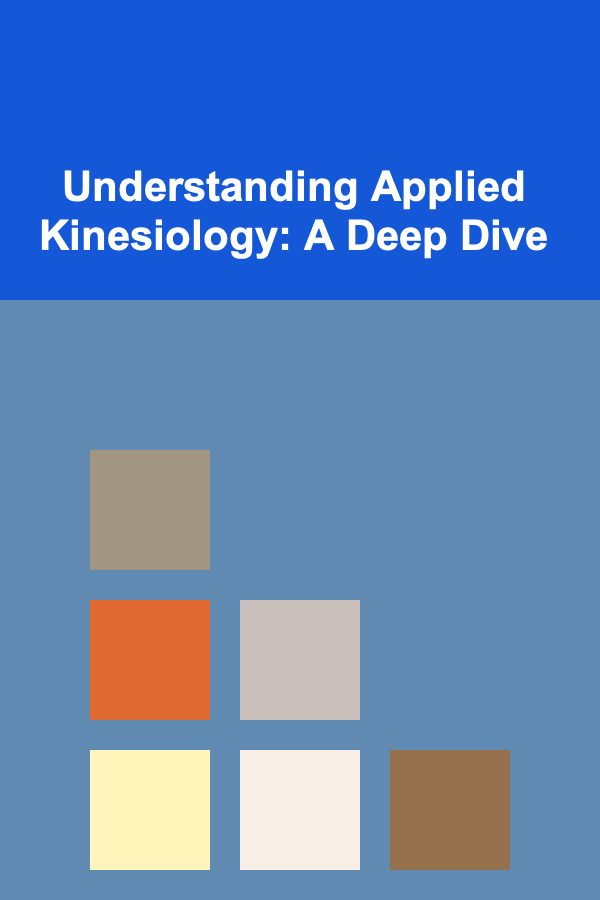
Understanding Applied Kinesiology: A Deep Dive
ebook include PDF & Audio bundle (Micro Guide)
$12.99$7.99
Limited Time Offer! Order within the next:

Introduction: Beyond Muscle Testing - A Holistic Approach
Applied Kinesiology (AK) is a diagnostic and therapeutic system used by various healthcare professionals, including chiropractors, medical doctors, dentists, and naturopaths. Often misunderstood as simply "muscle testing," AK is a much broader and more nuanced approach that aims to evaluate structural, chemical, and mental aspects of health. It's a system that utilizes manual muscle testing as a primary assessment tool to glean information about the functional state of the body and identify imbalances that may contribute to health problems. This document will delve into the core principles of AK, providing a comprehensive understanding of its methodology, its theoretical underpinnings, and its practical applications.
The Core Principle: The Triad of Health
At the heart of Applied Kinesiology lies the concept of the Triad of Health . This triad represents the three fundamental aspects of human health: structural , chemical , and mental/emotional. These three facets are interconnected and interdependent. When one aspect is out of balance, it can negatively impact the other two, potentially leading to a cascade of health issues. AK practitioners aim to assess and address imbalances in all three aspects of the triad to restore overall health and well-being.
- Structural Component: This encompasses the integrity of the musculoskeletal system, including bones, joints, muscles, ligaments, tendons, and posture. Structural imbalances can manifest as misalignments, muscle imbalances, postural distortions, and movement restrictions. AK addresses these through chiropractic adjustments, myofascial release techniques, cranial techniques, and other manual therapies.
- Chemical Component: This involves the body's biochemistry, including nutrition, digestion, hormones, neurotransmitters, and detoxification processes. Chemical imbalances can result from poor diet, nutritional deficiencies, allergies, sensitivities, toxic exposures, and hormonal imbalances. AK uses muscle testing to identify sensitivities, deficiencies, and imbalances, and recommends dietary changes, nutritional supplements, and detoxification protocols.
- Mental/Emotional Component: This encompasses the psychological and emotional state of the individual, including stress, anxiety, depression, unresolved trauma, and limiting beliefs. Mental and emotional stress can manifest as physical symptoms and exacerbate existing health problems. AK incorporates techniques such as Neuro-Emotional Technique (NET), Thought Field Therapy (TFT), and other mind-body therapies to address emotional blockages and promote emotional well-being.
The Triad of Health is not a hierarchical structure; all three sides are equally important and contribute to overall health. A problem in one area can manifest symptoms in another. For example, a structural problem like a misaligned vertebra can put stress on the nervous system, leading to chemical imbalances and emotional distress. Conversely, chronic emotional stress can lead to muscle tension, postural distortions, and digestive problems.
The Neurological Basis: Muscle Testing as a Diagnostic Tool
Applied Kinesiology utilizes manual muscle testing as its primary diagnostic tool. However, it's crucial to understand that muscle testing in AK is not about measuring brute strength. Instead, it's a neurological assessment of the neuromuscular system's response to a specific stimulus or challenge. The practitioner applies a gentle pressure to a specific muscle while the patient attempts to resist. The muscle's ability to hold its position against the pressure, or its "locking" ability, is assessed. A "strong" muscle indicates a properly functioning neurological pathway, while a "weak" muscle suggests a disruption or inhibition in that pathway.
The neurological basis of muscle testing involves several key components:
- Proprioception: Muscle spindles and Golgi tendon organs provide the brain with information about muscle length, tension, and position. This proprioceptive feedback is essential for coordinated movement and maintaining posture.
- Nervous System Integration: The nervous system integrates sensory information from the environment and the body to coordinate muscle contractions. Muscle testing assesses the integrity of these neural pathways.
- Spinal Reflexes: Muscle testing can assess the function of spinal reflexes, which are rapid, involuntary responses to stimuli. A weak muscle may indicate a disruption in a specific spinal reflex pathway.
- Cerebral Cortex Involvement: While many muscle tests rely on spinal reflexes, some tests involve higher-level brain function, particularly when assessing the effects of sensory stimuli or cognitive tasks.
It is imperative that the muscle testing procedure is performed correctly to ensure accurate results. This includes proper patient positioning, consistent pressure application, and a clear understanding of the muscle's function. The practitioner must also be aware of factors that can influence muscle strength, such as fatigue, pain, dehydration, and emotional stress.
Understanding the "Challenge": Stimuli and the Autonomic Nervous System
A key element of Applied Kinesiology is the concept of the "challenge." The practitioner introduces a specific stimulus or challenge to the patient and then observes the effect on a pre-selected indicator muscle. This challenge can take many forms, including:
- Nutritional Substances: Holding a food or supplement in the patient's hand can challenge the chemical aspect of the Triad of Health. A weakening of the indicator muscle suggests a negative reaction to that substance.
- Acupuncture Points: Touching or stimulating specific acupuncture points can challenge the energetic system and provide information about organ function and meridian balance.
- Structural Components: Applying gentle pressure to a specific joint or vertebra can challenge the structural aspect of the Triad of Health. A weakening of the indicator muscle suggests a structural imbalance in that area.
- Emotional Statements: Having the patient think about or verbalize a specific emotional statement can challenge the mental/emotional aspect of the Triad of Health. A weakening of the indicator muscle suggests an unresolved emotional issue.
- Environmental Stimuli: Exposure to electromagnetic fields, chemicals, or other environmental toxins can challenge the body's ability to adapt and detoxify.
The underlying principle is that these challenges exert a subtle stress on the body, triggering a response from the autonomic nervous system (ANS). The ANS is responsible for regulating involuntary functions such as heart rate, breathing, digestion, and immune function. When the body is faced with a stressor, the ANS activates the "fight-or-flight" response, which can temporarily weaken certain muscles. The AK practitioner uses muscle testing to detect these subtle changes in muscle strength, providing insights into the body's response to various stimuli.
The ANS can be divided into two branches: the sympathetic nervous system (SNS) and the parasympathetic nervous system (PNS). The SNS is responsible for the "fight-or-flight" response, while the PNS is responsible for the "rest-and-digest" response. A healthy body can effectively switch between these two states as needed. However, chronic stress can lead to an overactivation of the SNS, which can negatively impact health. AK aims to identify and address imbalances in the ANS to restore optimal function.
Muscle Testing: Beyond a Simple "Yes" or "No"
While muscle testing can be used to determine whether a substance is "good" or "bad" for the individual, it's important to understand that it's not a simple "yes" or "no" test. The results of muscle testing should be interpreted in the context of the patient's overall health history, physical examination findings, and other diagnostic tests. A weak muscle does not necessarily mean that a substance is inherently toxic or that a structure is severely damaged. Instead, it suggests that the body is experiencing stress in response to that specific stimulus, and that further investigation is warranted.
Factors that influence the interpretation of muscle testing results include:
- Individual Variability: Every individual is unique, and their response to various stimuli will vary depending on their genetic makeup, lifestyle, and overall health status.
- Compensation Mechanisms: The body has remarkable ability to compensate for imbalances. A weak muscle may be a result of a compensation pattern rather than a primary problem.
- Hydration Status: Adequate hydration is essential for optimal muscle function. Dehydration can lead to muscle weakness and inaccurate test results.
- Electrolyte Balance: Electrolytes such as sodium, potassium, and calcium are essential for nerve and muscle function. Imbalances in these electrolytes can affect muscle strength.
- Stress Levels: Emotional and physical stress can significantly impact muscle strength. It's important to minimize stress during muscle testing to obtain accurate results.
A skilled AK practitioner will take all of these factors into account when interpreting muscle testing results and developing a treatment plan. They will also use other diagnostic tools, such as observation, palpation, and laboratory tests, to confirm their findings and gain a more complete understanding of the patient's health status.
Techniques Used in Applied Kinesiology: A Multimodal Approach
Applied Kinesiology is not a single technique but rather a system that incorporates a variety of diagnostic and therapeutic modalities. Based on the findings from muscle testing and other assessments, the AK practitioner will develop a personalized treatment plan that addresses the imbalances in the Triad of Health. Common techniques used in AK include:
- Chiropractic Adjustments: To correct vertebral misalignments and restore proper joint function. Adjustments help to reduce nerve interference and improve communication between the brain and the body.
- Myofascial Release Techniques: To release muscle tension and improve flexibility. Myofascial release techniques involve applying sustained pressure to tight areas of muscle and fascia.
- Acupuncture and Meridian Therapy: To balance the flow of energy along the meridians. Acupuncture involves stimulating specific points on the body with needles, while meridian therapy uses other methods such as acupressure or laser therapy.
- Nutritional Therapy: To address nutritional deficiencies and sensitivities. Nutritional therapy involves recommending dietary changes, nutritional supplements, and detoxification protocols.
- Cranial Techniques: To address imbalances in the craniosacral system. Cranial techniques involve gentle manipulation of the bones of the skull and sacrum to improve cerebrospinal fluid flow and reduce nerve interference.
- Neuro-Emotional Technique (NET): To address emotional blockages and release unresolved trauma. NET involves identifying and releasing emotional patterns that are stored in the body.
- Lymphatic Drainage: To improve lymphatic circulation and detoxification. Lymphatic drainage involves gentle massage techniques to stimulate the flow of lymph fluid.
- Homeopathy: Using diluted substances to stimulate the body's healing response.
The choice of techniques will depend on the individual patient's needs and the findings from the AK assessment. The goal is to restore balance and harmony to the Triad of Health and promote overall health and well-being.
The Importance of Precision and Training
Applied Kinesiology requires rigorous training and a thorough understanding of anatomy, physiology, neurology, and nutrition. It is essential to seek treatment from a qualified and certified AK practitioner. Incorrect muscle testing or misinterpretation of results can lead to inaccurate diagnoses and ineffective treatment.
Proper training in AK includes:
- Comprehensive Knowledge of Anatomy and Physiology: A strong understanding of the human body is essential for accurate muscle testing and diagnosis.
- Neurology and Muscle Function: Understanding the neurological pathways involved in muscle control is critical for interpreting muscle testing results.
- Muscle Testing Techniques: Mastering the proper techniques for performing muscle testing is essential for obtaining accurate results.
- Clinical Application: Learning how to apply AK principles in a clinical setting and integrate them with other diagnostic and therapeutic modalities.
- Continuing Education: Staying up-to-date on the latest research and advancements in AK.
The International College of Applied Kinesiology (ICAK) is the certifying body for Applied Kinesiology. Practitioners who have completed the ICAK certification program have demonstrated a high level of competency in AK principles and techniques. It is advisable to seek treatment from an ICAK-certified practitioner to ensure quality care.
Criticisms and Scientific Evidence: Addressing the Skepticism
Applied Kinesiology has faced criticism from some members of the scientific community, primarily due to the subjective nature of muscle testing and the lack of large-scale, double-blind studies supporting its efficacy. Some studies have shown inconsistent results, while others have questioned the reliability and validity of muscle testing as a diagnostic tool.
However, proponents of AK argue that:
- Traditional Research Paradigms May Not Be Suitable: The complexity of the human body and the individualized nature of AK treatments make it difficult to study using traditional research methods.
- Muscle Testing Reflects Neurological Changes: While the exact mechanisms are not fully understood, muscle testing appears to reflect subtle changes in the nervous system's response to various stimuli.
- Clinical Experience Supports Its Effectiveness: Many AK practitioners have reported positive clinical outcomes in their patients, although this evidence is largely anecdotal.
While more research is needed to fully understand the mechanisms and validate the efficacy of AK, it is important to consider the limitations of current research methods and the potential benefits that AK may offer to some individuals. Future research should focus on developing more objective and reliable methods for assessing muscle function and evaluating the clinical outcomes of AK treatments.
It is crucial for practitioners to be transparent with their patients about the limitations of AK and to integrate it with other evidence-based diagnostic and therapeutic approaches. The responsible and ethical use of AK involves a commitment to patient safety, informed consent, and ongoing learning.
Conclusion: Integrating Applied Kinesiology into a Holistic Healthcare Model
Applied Kinesiology is a complex and multifaceted system that offers a unique perspective on health and disease. By focusing on the Triad of Health and utilizing muscle testing as a diagnostic tool, AK practitioners aim to identify and address imbalances in the structural, chemical, and mental/emotional aspects of the individual. While AK has faced criticism and requires further scientific validation, it has the potential to be a valuable tool for healthcare professionals who are committed to providing holistic and individualized care.
Understanding the principles of Applied Kinesiology requires a willingness to think outside the box and embrace a more holistic view of health. It's a system that encourages practitioners to listen to the body's innate wisdom and to work in partnership with the patient to restore balance and promote healing. When practiced responsibly and ethically, Applied Kinesiology can be a valuable addition to a comprehensive healthcare approach.

How to Find the Best Home Depot Artificial Christmas Trees Pre Lit
Read More
How to Invest in Startups and Angel Funding
Read More
How to Soundproof Your Garage for a More Comfortable Workspace
Read More
How to Use Bins and Baskets for Workspace Storage Solutions
Read More
The Top Ways to Make Money with Deep Learning Models and Algorithms
Read More
Creating a Healthy Work-Life Balance as a Nomad
Read MoreOther Products

How to Find the Best Home Depot Artificial Christmas Trees Pre Lit
Read More
How to Invest in Startups and Angel Funding
Read More
How to Soundproof Your Garage for a More Comfortable Workspace
Read More
How to Use Bins and Baskets for Workspace Storage Solutions
Read More
The Top Ways to Make Money with Deep Learning Models and Algorithms
Read More